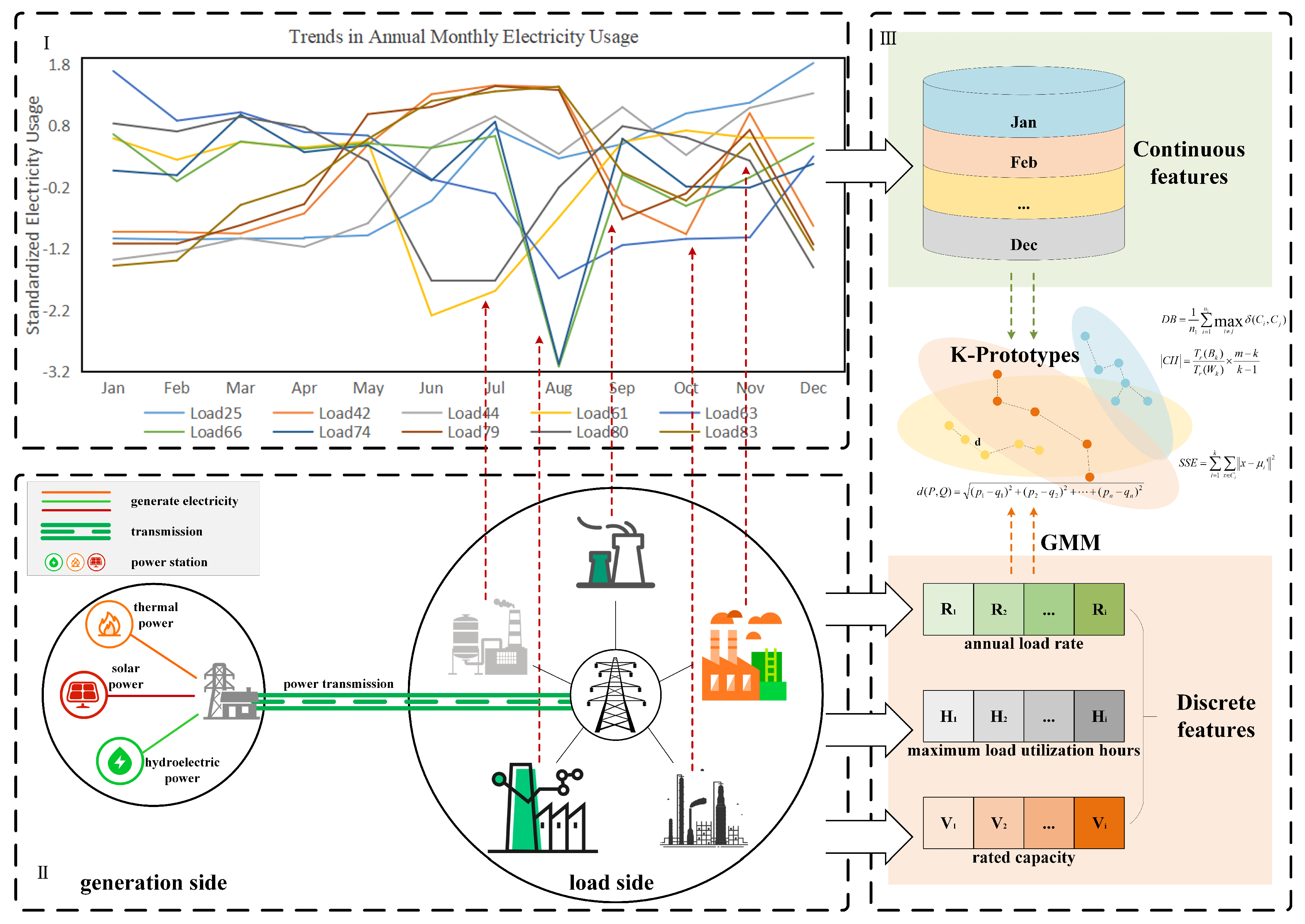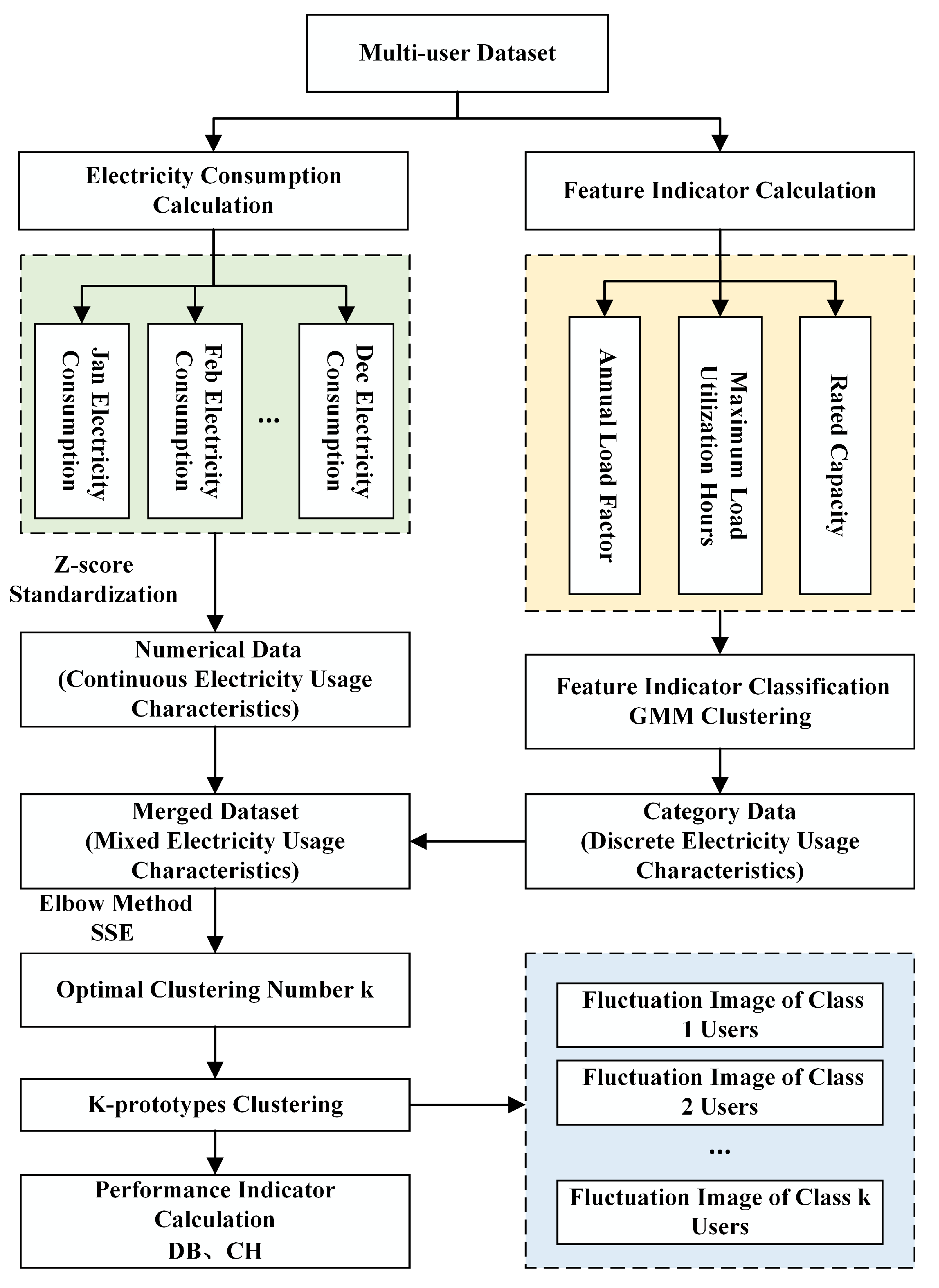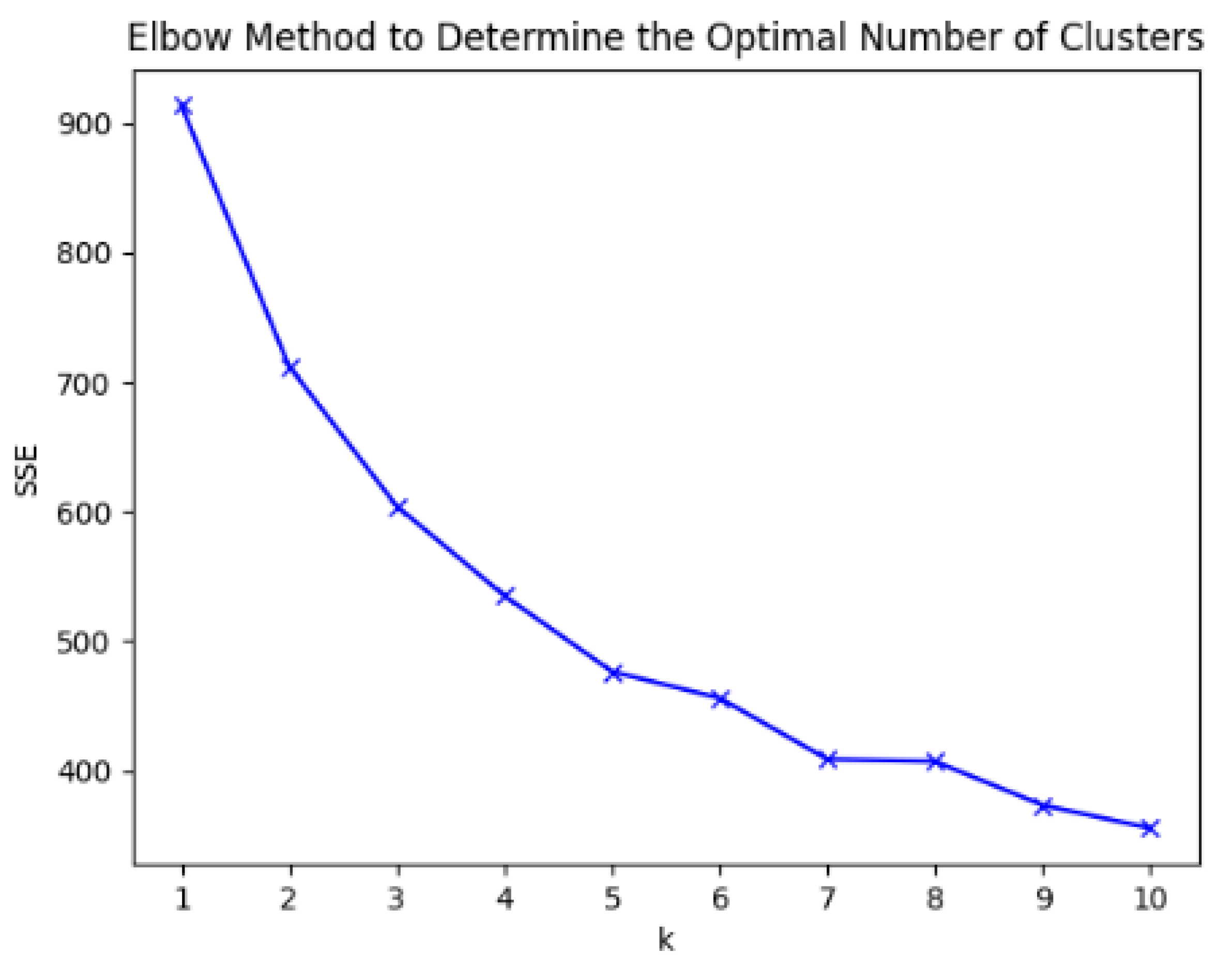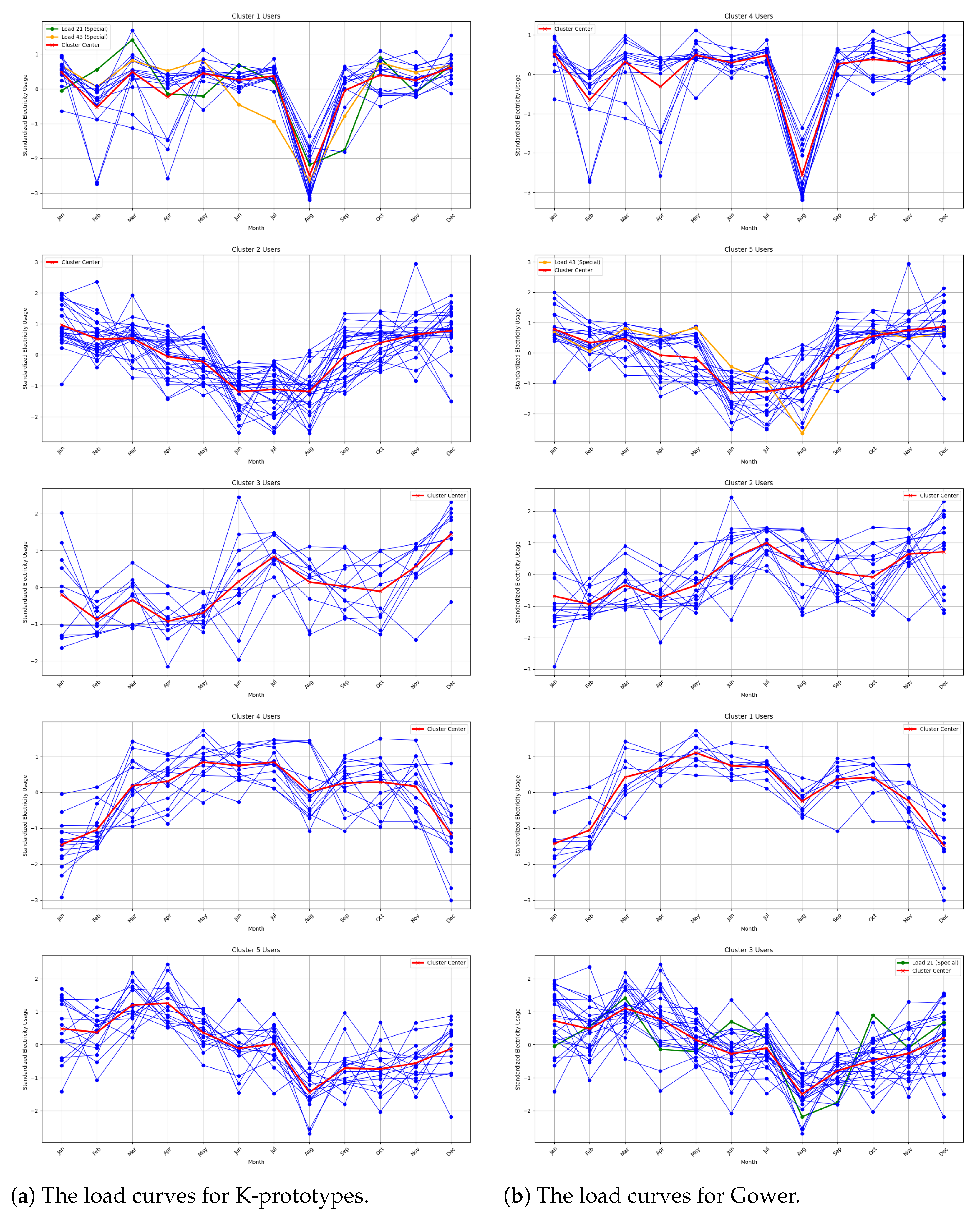A Load Classification Method Based on Hybrid Clustering of Continuous–Discrete Electricity Consumption Characteristics
Abstract
1. Introduction
- In addition to utilizing the continuous feature of historical load data, this paper also proposes three load characteristic indicators that can quantify user electricity consumption behavior to a certain extent. The hybrid electricity characteristics can more comprehensively describe the behavioral characteristics of the load side.
- Considering that different characteristic indicators often vary in magnitude and that power grid companies pay more attention to the relative level of each user’s characteristic indicators, the discrete power consumption characteristics are extracted by the GMM clustering algorithm based on the values of the indicators.
- On the basis of appropriately selecting the weights of continuous and discrete power consumption characteristics, a load classification method based on the K-prototypes hybrid clustering is proposed.
2. Methodology
2.1. Data Analysis and Feature Extraction
2.2. GMM Clustering Principle
2.3. K-Prototypes Clustering Principle
3. Load Classification Method
3.1. Classification Process
3.2. Performance Indicator
3.2.1. The SSE Indicator
3.2.2. The DB Indicator
3.2.3. The CH Indicator
4. Experiment and Analysis
4.1. Experimental Process and Parameter Setting
4.2. Comparative Experiment and Results Analysis
- Cluster 1: In this type of load in August, power consumption decreased significantly, while the other months showed relatively stable fluctuations, mainly for smelting and material processing industrial users, taking into account the impact of high summer temperatures.
- Cluster 2: In this type of load, from January to June, consumption decreased, from June to August it remained at a low level, and then it increased from August to December; this belongs to the summer low-load type, mainly including smelting and chemical loads.
- Cluster 3: The electricity demand of this type of load is low from February to May, and the electricity demand is high near July and December, mainly for railway-type users.
- Cluster 4: The annual electricity consumption of this type of load generally shows a trend of first rising and then declining; within this trend, the electricity consumption is relatively high from May to June, and the electricity demand is the lowest in January, mainly for water conservancy and cement manufacturing industry users.
- Cluster 5: The peak electricity consumption period for this type of load is between March and April, with the lowest electricity demand in August, which belongs to the spring high-load type, mainly for oil and gas industry users.
5. Discussion
6. Conclusions
Author Contributions
Funding
Data Availability Statement
Conflicts of Interest
References
- Ghasempour, A.; Martínez-Ramón, M. Short-Term Electric Load Prediction in Smart Grid using Multi-Output Gaussian Processes Regression. In Proceedings of the 2023 IEEE Kansas Power and Energy Conference (KPEC), Manhattan, KS, USA, 27–28 April 2023; pp. 1–6. [Google Scholar] [CrossRef]
- Pavlatos, C.; Makris, E.; Fotis, G.; Vita, V.; Mladenov, V. Enhancing Electrical Load Prediction Using a Bidirectional LSTM Neural Network. Electronics 2023, 12, 4652. [Google Scholar] [CrossRef]
- Cao, Z.; Wang, J.; Yin, L.; Wei, D.; Xiao, Y. A hybrid electricity load prediction system based on weighted fuzzy time series and multi-objective differential evolution. Appl. Soft Comput. 2023, 149, 111007. [Google Scholar] [CrossRef]
- Wu, D.; Du, X.; Peng, F. Multi-layer and multi-source features stacking ensemble learning for user profile. Electr. Power Syst. Res. 2024, 229, 110128. [Google Scholar] [CrossRef]
- Wen, Z.; Hongbo, G.; Bao, Y.; Yan, C.; Hong, O.; Jing, Z.; Furong, Y. Research on load forecasting method based on power user profile. In Proceedings of the 2022 IEEE 5th International Conference on Automation, Electronics and Electrical Engineering (AUTEEE), Shenyang, China, 18–20 November 2022; pp. 200–204. [Google Scholar] [CrossRef]
- Wang, X.; Yao, Z.; Papaefthymiou, M. A real-time electrical load forecasting and unsupervised anomaly detection framework. Appl. Energy 2023, 330, 120279. [Google Scholar] [CrossRef]
- Peng, B.; Liu, Y. Research on Power System Load Clustering based on Signal Analysis and K-Prototypes. In Proceedings of the 2023 3rd International Conference on Electrical Engineering and Control Science (IC2ECS), Hangzhou, China, 29–31 December 2023; IEEE: Piscataway, NJ, USA, 2023; pp. 233–240. [Google Scholar]
- Zhang, Y.; Zhang, F.; Yao, X.; Yu, J.; Wang, B.; Wang, L. Research on the classification of electricity consumption characteristics of massive users. In Proceedings of the 2022 4th International Conference on Intelligent Control, Measurement and Signal Processing (ICMSP), Hangzhou, China, 8–10 July 2022; IEEE: Piscataway, NJ, USA, 2022; pp. 679–682. [Google Scholar]
- Xiao, W.; Ding, T.; Chen, H. Load Characteristics Classification of Multiple Users Based on Time Series Clustering. In Proceedings of the 2021 11th International Conference on Power and Energy Systems (ICPES), Shanghai, China, 18–20 December 2021; IEEE: Piscataway, NJ, USA, 2021; pp. 569–574. [Google Scholar]
- Li, R.; Li, F.; Smith, N.D. Multi-resolution load profile clustering for smart metering data. IEEE Trans. Power Syst. 2016, 31, 4473–4482. [Google Scholar] [CrossRef]
- Li, D.; Liu, S.; Sun, Y.; Qiu, Y.; Liu, C.; Wang, S.; Cui, H.; Peng, T. Fine Classification Methods for Multi-load users at Different Time Scales. In Proceedings of the 2020 7th International Conference on Information Science and Control Engineering (ICISCE), Changsha, China, 18–20 December 2020; IEEE: Piscataway, NJ, USA, 2020; pp. 644–648. [Google Scholar]
- Fu-lin, M.; Hong-yang, L. Power load classification based on spectral clustering of dual-scale. In Proceedings of the 2014 IEEE International Conference on Control Science and Systems Engineering, Yantai, China, 29–30 December 2014; IEEE: Piscataway, NJ, USA, 2014; pp. 162–166. [Google Scholar]
- Cui, C.Y.; Ren, W.; Feng, S.; Jia, T.; Wang, H. User Seasonal Electricity Behavior Portrait Based on Data Feature Extraction and K-Means Clustering. In Proceedings of the 2023 IEEE 11th Joint International Information Technology and Artificial Intelligence Conference (ITAIC), Chongqing, China, 8–10 December 2023; IEEE: Piscataway, NJ, USA, 2023; Volume 11, pp. 1475–1479. [Google Scholar]
- Zhang, L.; Chen, Y.; Han, Z. Traction load classification method based on improved clustering method. J. Southwest Jiaotong Univ. 2020, 55, 27–33. [Google Scholar]
- Wang, P.; Zhang, W.; Ma, M.; Jin, W.; Wang, X. Research on load data classification method based on the characteristics of electricity consumption behavior by extreme learning machine. In Proceedings of the 2023 IEEE International Conference on Sensors, Electronics and Computer Engineering (ICSECE), Jinzhou, China, 18–20 August 2023; pp. 1259–1264. [Google Scholar] [CrossRef]
- Song, R.; Yang, Y.; Xue, Y.; Zhang, P.; Wang, C.; Yang, L. Research on clustering algorithm of user electricity behavior for identification of typical should scene. In Proceedings of the 2021 International Conference on Wireless Communications and Smart Grid (ICWCSG), Hangzhou, China, 13–15 August 2021; pp. 213–216. [Google Scholar] [CrossRef]
- Yang, H.; Li, X.; Su, M.; Liu, J.; Zhang, R. Power Consumption Portrait of Users Based on Improved ISODATA Clustering Algorithm. In Proceedings of the 2022 9th International Forum on Electrical Engineering and Automation (IFEEA), Zhuhai, China, 4–6 November 2022; pp. 1060–1064. [Google Scholar] [CrossRef]
- Zhu, Y.; Cheng, R.; Zhang, F.; Li, F.; Zheng, X.; Wang, J. Double-Layer Improved K-Means Based Electricity Industry Classification Method. In Proceedings of the 2021 International Conference on Wireless Communications and Smart Grid (ICWCSG), Hangzhou, China, 13–15 August 2021; pp. 513–516. [Google Scholar] [CrossRef]
- Hu, H.; Wang, Y.; Han, J.; Zhang, Y.; Yan, Q. Analysis of user power consumption characteristics and behavior portrait based on KS-rf algorithm. In Proceedings of the 2021 IEEE/IAS Industrial and Commercial Power System Asia (I&CPS Asia), Chengdu, China, 18–21 July 2021; IEEE: Piscataway, NJ, USA, 2021; pp. 1586–1590. [Google Scholar]
- Wang, J.; Wang, K.; Jia, R.; Chen, X. Research on load clustering based on singular value decomposition and k-means clustering algorithm. In Proceedings of the 2020 Asia Energy and Electrical Engineering Symposium (AEEES), Chengdu, China, 29–31 May 2020; IEEE: Piscataway, NJ, USA, 2020; pp. 831–835. [Google Scholar]
- Liu, J. Cluster analysis of electricity consumption characteristics and electricity consumption behavior of typical industry users. In Proceedings of the 2023 5th Asia Energy and Electrical Engineering Symposium (AEEES), Chengdu, China, 23–26 March 2023; IEEE: Piscataway, NJ, USA, 2023; pp. 1389–1395. [Google Scholar]
- Tian, L.; Liu, J.; Zhao, B.; Luan, W. An Investigation on Electricity Consuming Features for User Classification in Demand-Side Management Schemes. In Proceedings of the 2021 IEEE 5th Conference on Energy Internet and Energy System Integration (EI2), Taiyuan, China, 22–24 October 2021; IEEE: Piscataway, NJ, USA, 2021; pp. 554–559. [Google Scholar]
- Zhong, C.; Shao, J.; Zheng, F.; Zhang, K.; Lv, H.; Li, K. Research on Electricity Consumption Behavior of Electric Power Users Based on Tag Technology and Clustering Algorithm. In Proceedings of the 2018 5th International Conference on Information Science and Control Engineering (ICISCE), Zhengzhou, China, 20–22 July 2018; pp. 459–462. [Google Scholar] [CrossRef]
- He, F.; Wu, M.; Zhao, Y. Research on Community User Clustering Based on Multidimensional Power Consumption Features. In Proceedings of the 2020 Prognostics and Health Management Conference (PHM-Besançon), Besancon, France, 4–7 May 2020; pp. 314–319. [Google Scholar] [CrossRef]
- Fan, R.; Jing, Z.; Guo, D. Digital Marketing Technology Based on Electricity User Portrait and K-means Clustering Algorithm. In Proceedings of the 2022 IEEE Conference on Telecommunications, Optics and Computer Science (TOCS), Dalian, China, 11–12 December 2022; pp. 800–806. [Google Scholar] [CrossRef]
- Huang, Z. Extensions to the k-means algorithm for clustering large data sets with categorical values. Data Min. Knowl. Discov. 1998, 2, 283–304. [Google Scholar] [CrossRef]
- Pasarate, S.; Shedge, R. Concept based document clustering using K prototype Algorithm. In Proceedings of the 2018 International Conference on Control, Power, Communication and Computing Technologies (ICCPCCT), Kannur, India, 23–24 March 2018; IEEE: Piscataway, NJ, USA, 2018; pp. 579–583. [Google Scholar]
- Zhao, B.; Fan, K.; You, W.; Yang, K.; Wang, Z.; Li, H. A Weight-based k-prototypes algorithm for anomaly detection in smart grid. In Proceedings of the ICC 2020–2020 IEEE International Conference on Communications (ICC), Dublin, Ireland, 7–11 June 2020; IEEE: Piscataway, NJ, USA, 2020; pp. 1–6. [Google Scholar]
- Setianingsih, E.S.; Pratiwi, H.; Susanti, Y.; Nirwana, M.B. Clustering of Risk Factors for Coronary Heart Disease Using The k-prototypes Algorithm. In Proceedings of the 2023 3rd International Conference on Electrical, Computer, Communications and Mechatronics Engineering (ICECCME), Tenerife, Canary Islands, Spain, 19–21 July 2023; IEEE: Piscataway, NJ, USA, 2023; pp. 1–6. [Google Scholar]
- Davies, D.L.; Bouldin, D.W. A cluster separation measure. IEEE Trans. Pattern Anal. Mach. Intell. 1979, PAMI-1, 224–227. [Google Scholar] [CrossRef]
- Caliński, T.; Harabasz, J. A dendrite method for cluster analysis. Commun.-Stat.-Theory Methods 1974, 3, 1–27. [Google Scholar] [CrossRef]




| Methodology | Features Selection |
|---|---|
| Random forest [19] | Fourteen features (daily sum load, daily maximum load, daily minimum load, etc.) |
| K-means [20] | Eight features (peak valley difference, maximum utilization hours, daily peak valley ratio, etc.) |
| Affinity propagation [21] | Eight features (monthly electricity consumption, average weekly daily electricity consumption, etc.) |
| ReliefF [22] | Fourteen features (time index corresponding to , time index corresponding to , etc.) |
| K-means [23] | Nine features (contract capacity, category of EPS, seasonal characteristics, etc.) |
| K-means+ [24] | Seven features (peak hour load rate, valley hour load rate, average load, load ratio coefficient, etc.) |
| K-means [25] | Five features (daily electricity consumption, daily valley-to-peak, seasonal fluctuation, etc.) |
| Parameter | Definition |
|---|---|
| Annual load rate | |
| Maximum load utilization hours | |
| Euclidean distance between points P and Q | |
| w | Weight factor |
| Average tightness of the i-th cluster | |
| Similarity between the i-th and j-th clusters | |
| Global centroid | |
| Centroid of the i-th cluster | |
| Within-class dispersion matrix | |
| Between-class dispersion matrix |
| Category | Annual Load Rate | Maximum Load Utilization Hours | Rated Capacity |
|---|---|---|---|
| First | |||
| Second | |||
| Third | |||
| Fourth |
| Clustering Algorithm | DB Indicator | CH Indicator |
|---|---|---|
| K-means | 1.41 | 19.90 |
| GMM | 1.47 | 19.54 |
| Gower | 1.52 | 18.13 |
| K-prototypes | 1.397 | 19.94 |
Disclaimer/Publisher’s Note: The statements, opinions and data contained in all publications are solely those of the individual author(s) and contributor(s) and not of MDPI and/or the editor(s). MDPI and/or the editor(s) disclaim responsibility for any injury to people or property resulting from any ideas, methods, instructions or products referred to in the content. |
© 2025 by the authors. Licensee MDPI, Basel, Switzerland. This article is an open access article distributed under the terms and conditions of the Creative Commons Attribution (CC BY) license (https://creativecommons.org/licenses/by/4.0/).
Share and Cite
Li, J.; Ma, Y.; Li, H.; Liu, Y.; Li, Y. A Load Classification Method Based on Hybrid Clustering of Continuous–Discrete Electricity Consumption Characteristics. Processes 2025, 13, 1208. https://doi.org/10.3390/pr13041208
Li J, Ma Y, Li H, Liu Y, Li Y. A Load Classification Method Based on Hybrid Clustering of Continuous–Discrete Electricity Consumption Characteristics. Processes. 2025; 13(4):1208. https://doi.org/10.3390/pr13041208
Chicago/Turabian StyleLi, Jing, Yarong Ma, Hao Li, Yue Liu, and Yalong Li. 2025. "A Load Classification Method Based on Hybrid Clustering of Continuous–Discrete Electricity Consumption Characteristics" Processes 13, no. 4: 1208. https://doi.org/10.3390/pr13041208
APA StyleLi, J., Ma, Y., Li, H., Liu, Y., & Li, Y. (2025). A Load Classification Method Based on Hybrid Clustering of Continuous–Discrete Electricity Consumption Characteristics. Processes, 13(4), 1208. https://doi.org/10.3390/pr13041208





